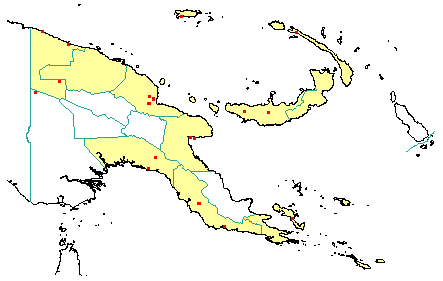
in PNGplants database
PNGTreesKey – Mastixiodendron pachyclados (K.Schum.) Melch. |
Barry Conn (NSW) & Kipiro Damas (LAE).
Guide to trees of Papua New Guinea
Copyright held by the authors, National Herbarium of New South Wales, and Papua New Guinea National Herbarium
Botanische Jahrbucher für Systematik, Pflanzengeschichte und Pflanzengeographie Vol. 60: 168 (1925)
Family: Rubiaceae
Dicotyledon
Timber Group: Commercial hardwood
Field Characters: Large canopy tree (up to 35 m high) or Small sub-canopy tree; Bole cylindrical (up to 120 cm diam.); straight (bole up to c. 20 m long); buttresses buttresses present (when present, buttresses usually small, sometimes up to 2 m high) or buttresses absent; spines spines absent; aerial roots aerial roots absent; stilt roots stilt roots absent; Bark brown or grey, rough, scaly or flaky; Subrhytidome (under-bark) yellow (pale (cream-coloured), mottled, dark red, or dark brown; less than 25 mm thick, 10.0-14.0; bark blaze with two layers; faintly to non-aromatic; outer blaze pale brown or yellow (cream-coloured), with stripes (orange), fibrous; inner blaze pink, yellow (pale (cream-coloured), or white, with stripes (orange), fibrous; bark exudate (sap) present, colourless, not readily flowing (spotty), colour changing on exposure to air, to black or dark brown, slightly sticky or not sticky; terminal buds enclosed by leaves.
Indumentum: Complex hairs absent; stinging hairs absent; mature twig indumentum (hairs) absent.
Leaves: Leaves spaced along branches, opposite (in pairs, opposite one another on the branchlet), simple (a leaf composed of a single blade); petiole present, not winged, attached to base of leaf blade, swollen (slightly (towards base and towards tip) or not swollen; leaves broadest above middle, 13.0-28.0 cm, 5.5-18.0 cm; symmetric, entire, not dissected or lobed, sub acute or acuminate (shortly), venation pinnate, secondary veins open, prominent, intramarginal veins absent; leaves lower surface pale green or green, upper surface dark green (glossy), indumentum (hairs) absent; absent; domatia absent; stipules present, joined, joined across twigs (slightly twisted), not encircling the twig or almost encircling the twig, leafy, not fringed, large (20-40 mm long, rarely as short as 15 mm), not persistent.
Flowers: Inflorescence axillary, flowers on a branched axis, cones absent; flowers bisexual, stalked, flowers with many planes of symmetry, 10.0-22.0 mm long, diameter large (more than10 mm diam.) (9-24 mm diam.); perianth present, with distinct sepals and petals whorls, inner perianth whitish yellow, white, or pale green; 4 (i(nner surface densely covered with white hairs), free; stamens 4, present, free of each other, free of the perianth; ovary partly inferior or inferior, carpels joined (when more than one), locules 2; styles solitary, 1.
Fruits: Infrutescence arranged on branched axis, fruit (12.0-) 20.0-35.0 (-45.0) mm long, (8.0-) 10.0-20.0 mm diam., green (probably immature) or dark yellow, not spiny, fleshy, simple, indehiscent, drupe; seeds 1, much more than 10 mm long (12-20 mm long) or about 10 mm long, not winged, narrow (longer than wide), seed 1-10 mm diam. (4-5 mm diam.).
Distribution: West Sepik, East Sepik, Madang, Morobe, Gulf, Central, Milne Bay, Papuan Islands, New Britain, New Ireland & Manus.
 | Botanical records in PNGplants database |